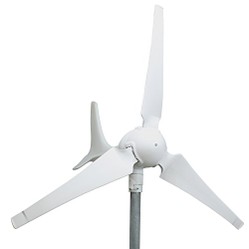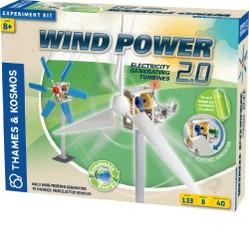Windmills as an alternative energy source must, to fulfill the current purpose of most windmills, generate electricity. Historically, windmills were used for other purposes, and some might still be found performing other tasks. They can be used to pump water from an aquifer, roll stones to grind grains, or any of a myriad of other mechanical purpose that requires a force to perform work. But, our main interest in windmills today is to generate electricity. And they can perform this duty quite well.
Basically, when an electric charge passes through a magnetic field, it experiences a force, depending or is magnitude, and the speed at which it moves perpendicular to the magnetic field lines. This force is at right angles to both the movement of the charge across the magnetic field and to the magnetic field itself. As an easy way to view this, if there is a magnetic field that is oriented north to south, and the movement of a charge is horizontal along the line from east to west, the force of the charge will be vertical, and thus change the path of the charge. Well, the choice of directions here is arbitrary, but the force is perpendicular to both the field and the movement relative to the field.
A windmill turns a coil of wire through a magnetic field. In any metal there are electrons that move from atom to atom freely, so they are free to be moved. As the coil or wire spins, it goes through a magnetic field. Opposite sides of the coil go through the field in opposite directions, so that causes the electrons to flow upward in one side of the coil, and downward in the other, or to move around the circle of the loop. The electrons are constrained to the wire. The moving current is taken off using conductive brushes, and can be made to flow in a circuit.
Notice that as the coil of wire spins it cuts the magnetic filed from parallel to the field, or no field lines crossed meaning no force, to perpendicular to the field, or a maximum force. The result is alternating current in a sinusoidal shape.








 Christmas on Zazzleon 10/21/2025
Christmas on Zazzleon 10/21/2025
 The Linear Equation and Related Equations and Inequalitieson 08/15/2024
The Linear Equation and Related Equations and Inequalitieson 08/15/2024
 Understanding Calculus: A Simplified Approach to Derivativeson 08/05/2024
Understanding Calculus: A Simplified Approach to Derivativeson 08/05/2024
 Limits: Vital Building Blocks of Calculuson 08/01/2024
Limits: Vital Building Blocks of Calculuson 08/01/2024



Comments
We haave one Trafford borough councillor who has her own wind turbine, but no one has complained.
I have seen windfarms while traveling to California, and the spacing is so vast between windmills they do not present a problem except for pictures of the scenery. The ones I refer to in the article are those for home use. People tend to not want such an object atop a roof.
As forthe aesthetics! Some people claim that the Liverpool Bay windfarm is an eyesore,but when we were walking the Great Orme I pointed to the windfarm and asked Maureen, "Do you think it an eyesore?" She simply said "What?" It in the distance and the haze the eyesore was nearly invisible. So much for spoling the view.
They are used in commercial production of energy, especially where wind flow is somewhat regular. Those are quite large. Home usage lags behind solar panels, possibly because of expense and possibly because they are more obvious.
Excellent explanations as always BSG,
There has been a huge investments in windfarms as we call them here in UK.
Some of them stand in the Irish Sea off the coast of NW England. Some stand on mountains. The aesthetics as you mention have been a source of controversy here in UK . But I like them especially when they stand in large groups on the hillsides.
Thank you for this.